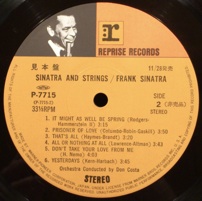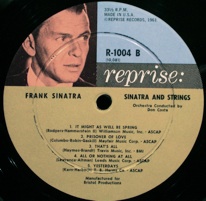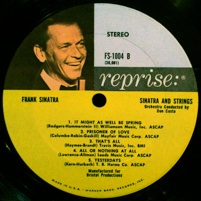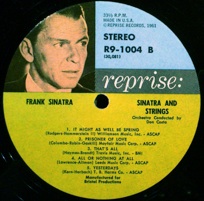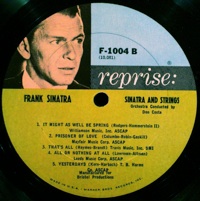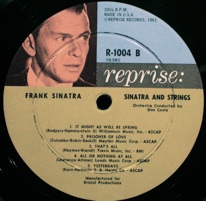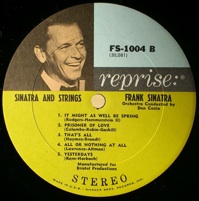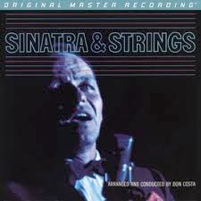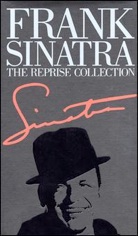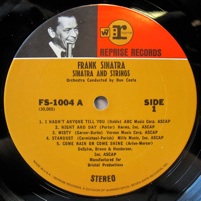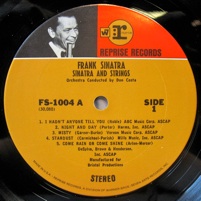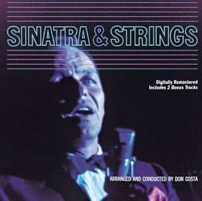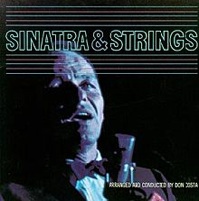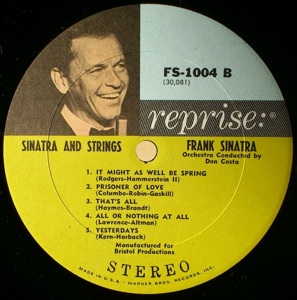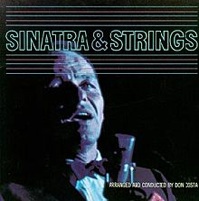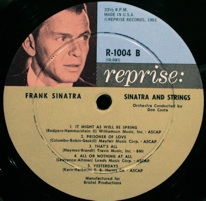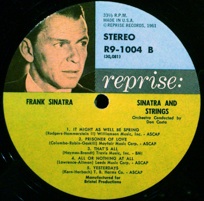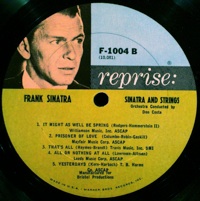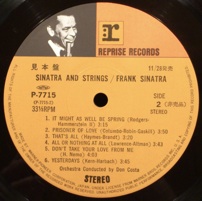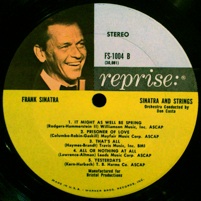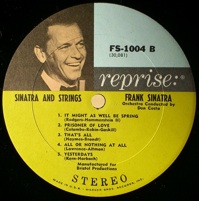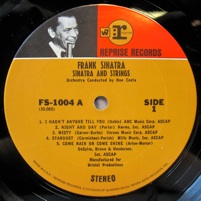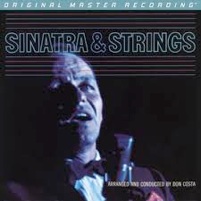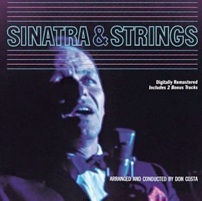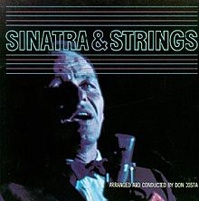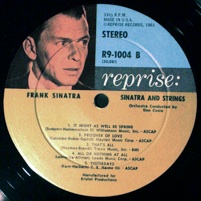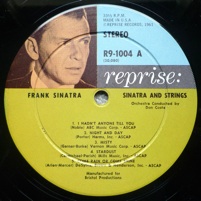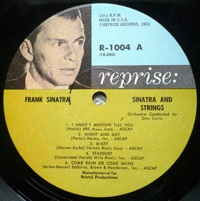Recorded November 20, 21, and 22, 1961
Arrangements: Don Costa
Conducted by Don Costa
Engineer: Bill “KT” Putnam
Original Release: January, 1962 (recorded after, but released prior to, Point of No Return
Sinatra & Strings - 1962
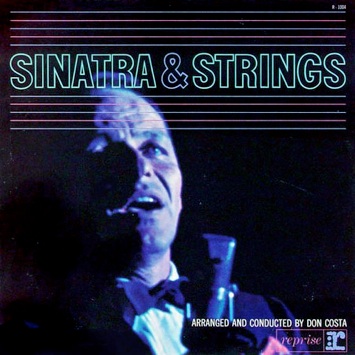


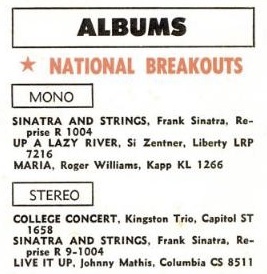

The first transitional clip covers, briefly, all three of the LP-era mixes for this album, starting with the 2nd LP-era stereo mix (source: 1990 The Reprise Collection CD), transitioning to the original “Slapback” stereo mix (source: FS 1004 1B LP, pressed by Columbia), and finishing with the original mono mix (source: F1004 1C LP, also pressed at Columbia).
Here’s that clip: ComeRainRepRoll-FS1004B2-F10041C.wav
Don’t jump to any assumptions about the mono mix being some sort of dry-vocal bliss! Different songs have different reverb levels on both the original stereo and original mono mix.
AUDIO SAMPLES:
All clips on this page fall within the freely available 90-second sample windows available to the public on iTunes. Click “VIEW,” then “View in iTunes” to access the 90-second clips.

ABOVE:
Original R-1004 A6 mono LP
AUDIO SAMPLES:
“COME RAIN OR COME SHINE”
(The clips happen to fall at a place that includes that painfully, blatantly wrong note in the bass part.)
ABOVE:
Original R-1004 A7 mono LP, courtesy “Arkoffs”
ABOVE:
Later F-1004 1C mono LP
ABOVE:
Original R9-1004 A2 LP
(ORIGINAL STEREO MIX)
ABOVE:
Later FS-1004 1B LP
(ORIGINAL STEREO MIX)
ABOVE:
Later FS-1004 1E LP
(ORIGINAL STEREO MIX)
ABOVE:
Later FS-1004 1F LP, courtesy “MMM”
(ORIGINAL STEREO MIX)
ABOVE:
Later FS-1004 1G LP, courtesy “Arkoffs”
(2nd STEREO MIX)
ABOVE:
1980s(?) Japanese P-7715 12-song LP
(2nd STEREO MIX)
AUDIO SAMPLES:
All clips on this page fall within the freely available 90-second sample windows available to the public on iTunes. Click “VIEW,” then “View in iTunes” to access the 90-second clips.

ABOVE:
2010 MFSL LP, courtesy “Blackie”
(2nd STEREO MIX)
ABOVE:
12-song 1991 CD (reused in “the suitcase,” 1995 (3rd STEREO MIX)
ABOVE:
1998 “Entertainer of the Century” CD, courtesy “aoxomoxoa” (4th STEREO MIX)
Transitional Clips:


The second transitional clip demonstrates just how similar the second stereo mix (LP era) is to the third stereo mix (early CD). In fact, it seems logical that the CD remix of 1991 was meant to be a “cleaned up” re-creation of that second stereo mix that had been in use for 20 years or more, improving the tone and dynamic range slightly, while not losing the “flavor.” The clip begins with 1990’s The Reprise Collection CD, which uses that second LP stereo mix. We then transition into the 1991 CD remix (“stereo mix #3”) only for the lines “but don’t you ever bet me, ‘cause I’m gonna be true if you let me,” and finally return to the Reprise Collection to finish out the clip. Click: ComeRainCollection-CD1991-Collection.wav.
To hear the entire The Reprise Collection clip (so you can do your own comparison to the clips at the top of the page), please click on the box at right.


While the first CD remix (“stereo mix #3”) seems to aim to recreate and improve upon the second LP mix (“stereo mix #2”), the 1998 EOTC CD remix (“stereo mix #4”) seems to give a strong nod to the original stereo LP mix, minus the slapback echo. The 1998 mix adds little or no perceivable reverb to the orchestra (unlike mixes 2 and 3), and even leaves the vocal quite dry.
Here is a clip from “Stardust” that starts with the original stereo mix (FS 1004 1F LP, courtesy MMM) of the instrumental opening, then repeats the same segment from the EOTC disc. After a pause, we hear the same order repeated, but in a vocal passage. Listen: StardustMMM-EOTC-MMM-EOTC.mp3. To my ears, the orchestra sounds identically treated (in a very hands-off way, which is good), and the vocal tone is also extremely similar, except for the difference in reverb.
Which brings us to The Strange Case of “All or Nothing at All.”
The original stereo mix has nine songs with slap-back reverb, but for some reason (and I would not rule out simple user error at the mixing session), the fourth song on side two, “All or Nothing at All,” is devoid of slapback. Here’s a clip from the FS 1004 1E LP (click label for audio):
AUDIO SAMPLES:
All clips on this page fall within the freely available 90-second sample windows available to the public on iTunes. Click “VIEW,” then “View in iTunes” to access the 90-second clips.


3B
Doesn’t that sound nice? With the slapback reverb now out of the picture, it’s possible to get a better feel for what’s really going on with the 1998 EOTC CD. How much, if any, vocal reverb was on the original 3-track tapes? How much was added during CD mixing? How much vocal compression was evident on the 3-track tapes? How much vocal compression was added during CD remixing? Here’s the same clip from the 1998 EOTC CD, courtesy SH.TV’s “aoxomoxoa” (stereo mix #4, for those keeping score at home):
(Click photo for audio clip)
AUDIO SAMPLES:
All clips on this page fall within the freely available 90-second sample windows available to the public on iTunes. Click “VIEW,” then “View in iTunes” to access the 90-second clips.

What’s up with the vocal tone on the EOTC CD? There are at least two things going on: Additional reverb is added, and the vocal track is significantly compressed. Let’s look at the compression first. Below are two waveforms, each showing the right channel only for the two clips already posted from these two stereo editions (1E LP and EOTC CD).
EOTC CD
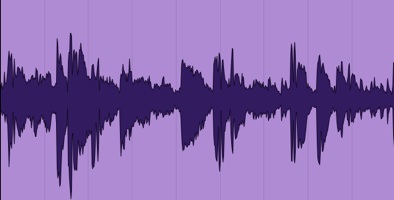
FS 1004 E1 LP (original stereo mix)
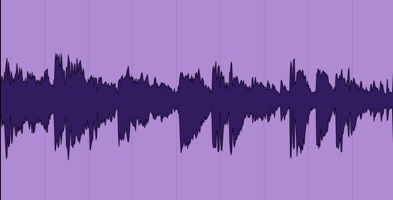
1998 EOTC CD (Stereo Mix #4)
In those two clips, the instrumental levels are matched. The tall vertical spikes show Sinatra’s vocal, and it’s clearly evident that in the EOTC mix, the vocal is being strongly limited -- no big spikes. Of course, what matters is how this affects the sound, and the sound of the vocal on the EOTC comes across as quite hard and unnatural. It doesn’t breathe; it doesn’t feel open. To illustrate, here are clips that alternate between the EOTC disc and the E1 LP, always starting with the CD and moving to the LP: All Or NothingEOTC-E1LP alt.wav. There is also some reverb clearly added to the EOTC vocal, which may be a good thing.
AUDIO SAMPLES:
“IT MIGHT AS WELL BE SPRING”
AUDIO SAMPLES:
All clips on this page fall within the freely available 90-second sample windows available to the public on iTunes. Click “VIEW,” then “View in iTunes” to access the 90-second clips.

AUDIO SAMPLES:
All clips on this page fall within the freely available 90-second sample windows available to the public on iTunes. Click “VIEW,” then “View in iTunes” to access the 90-second clips.
ABOVE:
Original R-1004 B6 mono LP
ABOVE:
Later F-1004 1C mono LP
ABOVE:
Original R9-1004 B8 LP
(ORIGINAL STEREO MIX)
ABOVE:
Later FS-1004 1A LP
(ORIGINAL STEREO MIX)
ABOVE:
Later FS-1004 1E LP
(ORIGINAL STEREO MIX)
ABOVE:
Later FS-1004 1D LP, courtesy “MMM”
(ORIGINAL STEREO MIX)
ABOVE:
1980s(?) Japanese P-7715 12-song LP
(2nd STEREO MIX)
AUDIO SAMPLES:
All clips on this page fall within the freely available 90-second sample windows available to the public on iTunes. Click “VIEW,” then “View in iTunes” to access the 90-second clips.

ABOVE:
2010 MFSL LP, courtesy “Blackie”
(2nd STEREO MIX)
ABOVE:
12-song 1991 CD (reused in “the suitcase,” 1995 (3rd STEREO MIX)
ABOVE:
1998 “Entertainer of the Century” CD, courtesy “aoxomoxoa” (4th STEREO MIX)
ABOVE:
Original R9-1004 B11 LP
(ORIGINAL STEREO MIX)

Break it down!
Sinatra nuts are a funny bunch. I’ve read comments that say that the only “real” version of Where Are You is the mono version, because it is consistent sounding from start to finish. If that’s your way of thinking, then the original stereo mix is out. I know that people just cannot stand the slapback reverb on Ring-A-Ding Ding. If that’s your way of thinking, both the original mono and stereo mixes are out. Some people can’t listen to Sinatra Sings for Only the Lonely in stereo because it’s too cavernous. If that’s your way of thinking, heaven help you if you ever have to sit through the second stereo mix (and, to a lesser degree, the third stereo mix). Some of us have little tolerance for added/unnecessary compression, so that means we can toss the fourth stereo mix. If you dislike Bill Putnam’s style, you’d better throw out the original mono mix, plus the first, second, third, and fourth stereo mixes.
Basically, to my ears, no version of this album is anywhere near perfect, and there isn’t even really much consistency from track to track on some versions. Here’s a breakdown for each song, and the more GREEN something is, the more I like it.
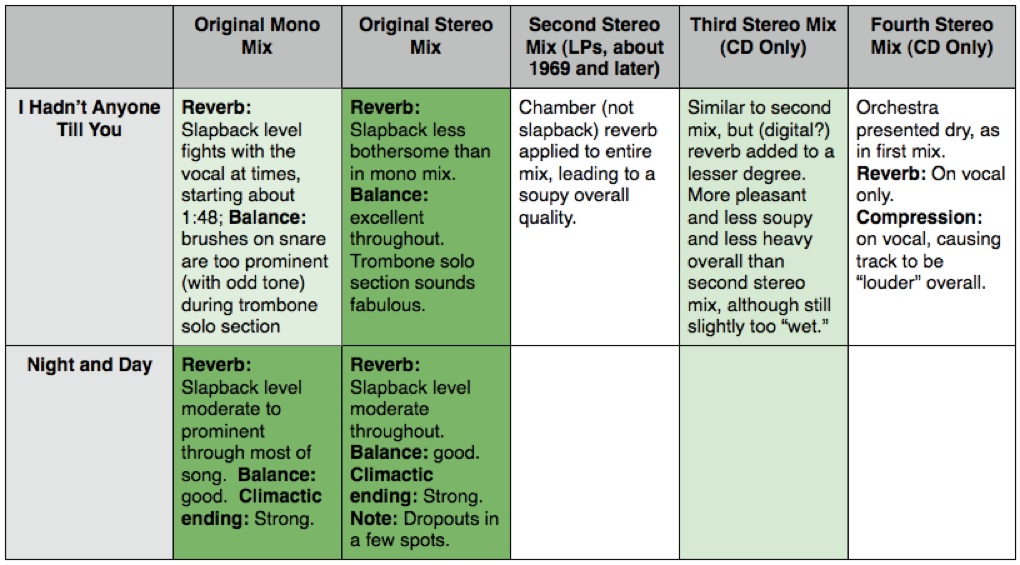



Conclusions?
•Mono Mix: Inconsistent on all fronts! On a 1 to 10 scale, I give it a 7.5. Some tracks are a solid 8.5; some more like a 6.
•Original Stereo Mix: If the sound of the orchestra is of major importance to you, this is the one to get. Don Costa’s arrangements are hardly masterworks of subtlety, and if heavy reverb or dark tonal qualities are added, a line gets crossed that drags the proceedings across the threshold into Mantovaniville, but the original stereo mix keeps the orchestral sound crisp and airy for the most part, and those qualities work to the music’s benefit to balance the built-in heavy earnestness of the arrangements. No other mix shows off the orchestra in such a positive light.
Now, the vocal is another matter. If you are able to flip that switch in your mind that tells you “slapback is not bad, slapback is not bad, slapback is not bad,” the original stereo mix is very, very nice. Dynamics are wide open, stereo spread is wide, and there’s virtually zero soup being served. Remember Barbara Mandrell and the Mandrell Sisters on NBC-TV? The left orchestra is Barbara Mandrell; the right orchestra is Louise Mandrell; the center is Irlene. If you go in with that fact in mind, you’ll get 35 minutes of solid entertainment.
•Second Stereo Mix: I have zero use for this mix. MFSL did a GREAT job (based on the clips I’ve heard) of mastering a poor stereo mix. Kudos to them for that accomplishment, but this mix is el-stinko.
•Third Stereo Mix: Mildly too reverberant throughout, but in some places it’s very close to being “spot on.” If you can’t hack the slapback, this is the one to get.
•Fourth Stereo Mix: A study in the whole not being equal to the sum of its parts. The orchestral tone is marvelous, but compressed. The vocal track is almost dry, but compressed. In small pieces, it’s a pleasant change from the usual reverb-ed versions, but it’s one hard-to-sit-through CD when taken as a whole, as the sound is hard and Frank seems to be yelling or, at least, too far forward. Avoid.
Recommendations?
•There’s something about the mono mix that greatly plays down the sweeping Cinemascopic grandeur of the arrangements, and makes the whole thing a little more low-key and intimate, and I’m quite fond of that. However, despite that huge “plus,” I cannot recommend the mono mix as my top choice, although it’s very good and has some truly fine moments.
•The third stereo mix (first CD mix) is a fairly pleasant “plain Jane” mix with good dynamics and “regular” reverb. It’s nice on its own terms, and (to my ears) unquestionably the best choice if you just can’t hack the slapback reverb that is on some versions. Less wet than the poorly done second stereo mix, it’s still wetter than it needs to be, but quite listenable and enjoyable.
•Despite my reservations about the slapback, I’ve found the original stereo mix to be the most enjoyable presentation of the album overall, largely because of the splendid light-and-citrusy flavors -- and overall reverb-free clarity -- bestowed upon the orchestra. It seems that early Columbia-pressed masterings are best, with 1A cuts being the cream of the crop, with only a very slight dip in quality by 1E, but significant drop in quality at 1F. As MMM pointed out, some cuts are quite low in levels, so you may want to be a little extra finicky in looking for truly top-grade vinyl on this one, since noise can easily become a problem.
•A remix by the right person is sorely needed. Fifth time’s the charm?????
FOR BONUS TRACK INFORMATION, CLICK HERE.

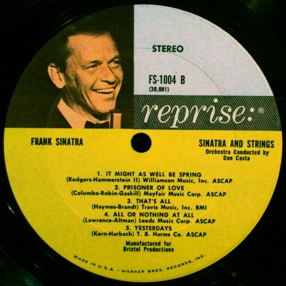
ABOVE:
Original R9-1004 A9 LP
(ORIGINAL STEREO MIX)
ABOVE:
Original R-1004 A5 mono LP
ABOVE:
Original R-1004 A1 mono LP
ABOVE:
Original R-1004 B3 mono LP
ABOVE:
Original R-1004 B5 mono LP
